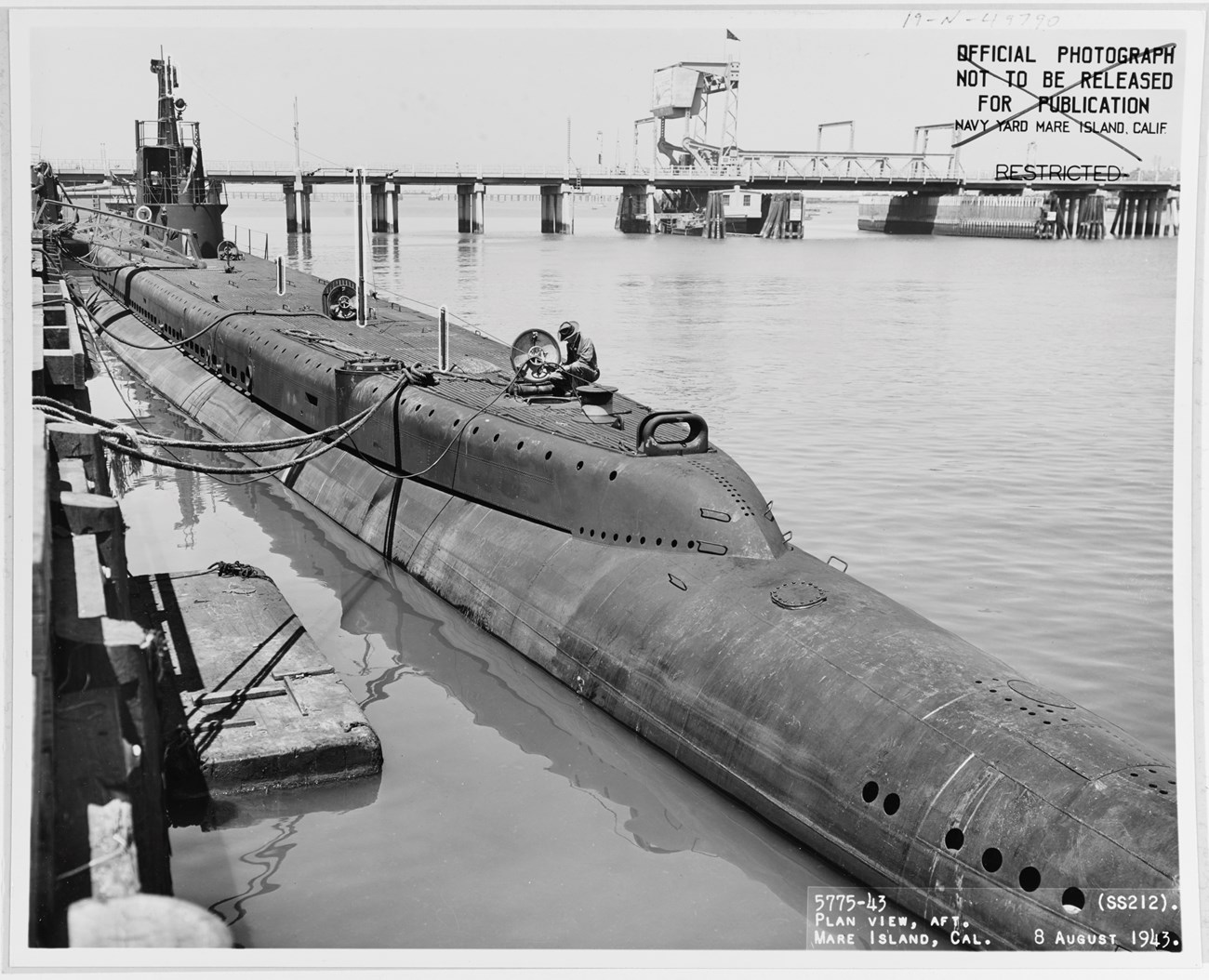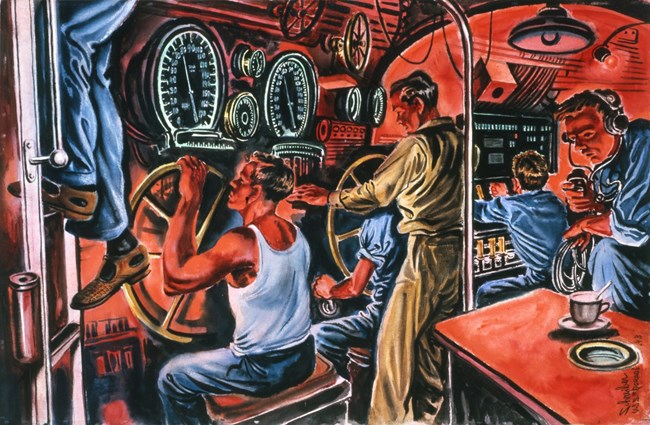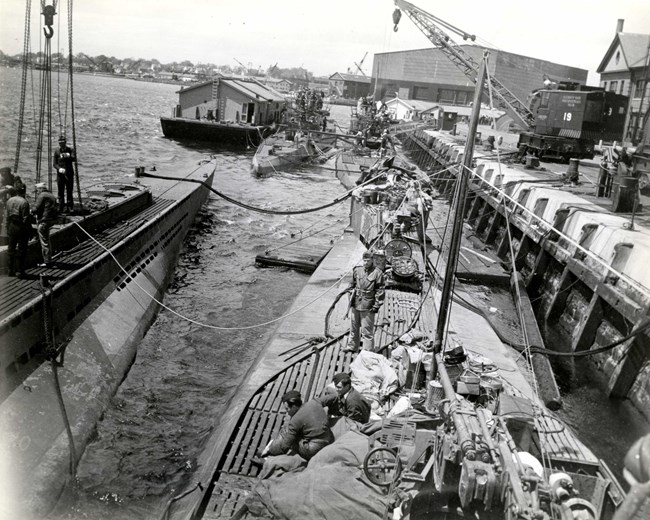Last updated: July 18, 2025
Article
Submarines in World War II

National Archives, 19-N-49790
Background of American Submarines
From the first American submarine is 1775 to the world’s first nuclear-powered submarine in 1955, the United States has had many successful submarines. While they weren’t used much during World War I, American submarines came into their own during World War II.
Gato-class submarines were the first mass-produced US submarines for World War II, between 1941 and 1943. Before the Gato-class, there were also twelve Tambor-class (like the Triton III and Tuna II) and six Gar-subclass submarines. Between 70 and 77 Gato-class submarines were produced, including the USS Grunion, built by the Electric Boat Company in Groton, CT. These submarines were larger and slower divers than some British and German submarines. American submarines offered quite a few comforts to the sailors on board. The Gatos had air conditioning, refrigerated food storage, freshwater distilling units, clothes washers, and bunks for everyone. Amenities like air conditioning were deemed necessary in the warm tropical waters. High humidity could condense, drip into electrical equipment, and cause electrical shorts or fires. After the Gato-class, the US Navy designed the Balao-class (120 submarines) and the Tench-class (40 submarines, including 11 built after World War II).
Being stationed on a submarine was often called the "Silent Service," since it was hard for people at home to hear news about the submarines, and their loved ones on them.

Georges Schreiber, Naval History and Heritage Command, 88-159-JK
Winning the War
Submarines not only attacked enemy ships, but also rescued downed pilots, and played other humanitarian roles. American submarines had the largest impact on the Imperial Japanese Navy and merchant ships, destroying their supply lines and extensive naval fleet. American submarines were primarily used in the Pacific Ocean, with minimal action in the Atlantic Ocean. German U-boats were predominantly used in the Atlantic.
According to Naval historian Gary E. Weir, “In all, U.S. submarines destroyed 1,314 enemy warships in the Pacific, representing 55% of all Axis power warships lost and a total of 5.3 million tons of shipping.”
The American success came at a cost, though. In World War II, 52 US submarines were lost, with a total of 3,506 officers and enlisted men killed. The US Navy Submarine Service had the highest casualty percentage of any American forces in the War: about 20%.
Torpedo Problems
The US Mark 14 torpedoes were the main ones fired from submarines during World War II. Unfortunately, some of the torpedoes had reoccurring problems. Even with perfect set up, many of the Mark 14 submarine-launched torpedoes would miss their targets and ended up about 10 feet below their target depth. Torpedoes needed to explode beneath enemy ships, where there was little to no armor to protect them. Once the depth problem was resolved (by setting the depth to zero) premature detonations and “dud” firings increased. The premature detonations might have been due to the Mark 6 exploder, one of the components of the torpedoes.
The Mark 6 exploder was magnetic, based on a German design used in World War I and more recent British designs. Where the Navy did its very limited field testing, the Earth’s magnetic field was different from where the actual fighting took place. This impacted the successful detonations. The magnetic exploders were triggered too soon, before reaching the enemy vessel. Once submariners began disabling the Mark 6 exploder (with official approval granted June 24, 1943), they started having more successful hits. Then a new problem was revealed. The contact exploder had major design flaws, causing lots of duds. After more testing and tinkering, the Navy replaced the faulty firing mechanisms. Electrical switches were installed instead of magnetic switches. It wasn’t until early 1944 that all the fixes were implemented for the Mark 14, and it because a reliable weapon.
Another flaw in the Mark 14 proved deadly for some American submariners. Sometimes the torpedo would circle around instead of shooting straight, risking the submarine that fired it. After decades of searching for their father, Lieutenant Commander Mannert “Jim” Abele, three brothers discovered that his World War II submarine, the USS Grunion. She was likely sunk by a torpedo they had fired at an enemy, that had circled around and hit them.

National Archives, 7330125
German U-Boats
German U-Boats (Underwasserboot or Unterseeboot) or submarines were a deadly threat to the Allied Forces in the Atlantic during World War II. While the Treaty of Versailles and the 1918 Armistice forced Germany to surrender all its U-boats and was supposed to prevent them from having U-boats in the future, Hitler repudiated the treaty and regained the right for Germany to build U-boats in 1935.
After successfully using U-boats in World War I, the Germans improved upon their designs for World War II. They made many different types of U-boats, but the most produced were the Type VII, the “workhorse” of the submarine fleet. The Type IX was like the VII but larger and designed for long-range patrols. One of the features that made U-boats such a deadly enemy include larger hulls to store more batteries for longer periods under water. Also, radar-warning receivers; anti-aircraft guns; snorkels for the diesel engines; special coatings to make them less of a sonar and radar target; and as artificial chemical bubble-making decoys.
To counter the strengths of U-boats, Allies began moving merchant ships in convoys, sometimes with trained escorts using radar to find approaching U-boats. Allies also used aircraft to attack U-boats and struck the U-boats’ supply vessels. This made it more difficult for the U-boats to succeed in their attacks.
Germany built 1,162 U-boats during World War II and 785 were destroyed by the end of the war. The remaining 377 U-boats were surrendered (or scuttled by the Germans). In contrast, U-boats sank about 3,000 Allied ships (merchant ships and warships).
Japanese I-Boats
Japan was known for its wide variety of submarines, from the largest I-400 class, capable of carrying airplanes, to the so-called “midget submarine,” which only had room for two people.
One of the better-known Japanese submarines was I-24, a Type C cruiser submarine. She was built for going long distances and was the “mothership” for a midget submarine. I-24 launched her (also famous) midget submarine, No. 19 (also called HA. 19) on December 7, 1941, as part of the attack on Pearl Harbor. No. 19 couldn’t enter the harbor and ran aground on reef. She was spotted by the USS Helm and fired upon. The shelling missed the submarine, but knocked her loose from the reef, disabled the torpedo firing mechanism, and knocked her commander unconscious. The two-man crew (Ensign Kazou Sakamaki and Chief Warrant Officer Kiyoshi Inagaki) eventually tried to self-destruct No. 19, but that did not work, forcing the men to abandon ship. Sakamaki and the submarine were captured, and Inagaki drowned. Sakamaki became the first Japanese Prisoner-of-War for the United States. No. 19 later was used to promote war bonds and toured all over the United States.
I-24 continued her war patrols around Midway, Guadalcanal, Australia, New Guinea, and the Aleutian Islands. She sank off Kiska on June 11, 1943. Her final mission was to help rescue any Japanese survivors after the United States re-took the Island of Attu. She was unable to contact any survivors on shore and headed to Kiska to patrol. American patrol boat PC-487 spotted the large submarine on sonar, radar, and visually before depth-charging I-24. They rammed her multiple times, and caused her to sink with all 104 men on board.
Despite the many types of Japanese submarines, they were not as successful carrying out attacks as the Germans. There also were not as many Japanese submarines built, as there were by other navies. Overall, the Japanese sank about 1 million tons of Allied merchant ships, trying to impact the supply chain. In contrast, German U-boats sank over 14 million tons, and Americans almost 5 million tons. By the end of the war, Japanese submarines were used to transport supplies to islands.
Additional Information and References
- World War II, NPS subject site
- Pearl Harbor Memorial, NPS
- Aleutian Islands World War II National Historic Area, NPS
- War in the Pacific National Historical Park, NPS
- History of the Submarine Force, Naval History and Heritage Command
- World War II Submarine Warfare, Department of Defense
- US Pacific Submarines in World War II, by William Gruner
- Torpedoes of World War II, Naval History and Heritage Command
- Art from the Silent Service, Naval History and Heritage Command
- AP News Article on the USS Dorado and the Artists on Board, by John Ruddy
- Imperial Japanese Navy Submarines, Naval Encyclopedia
- Japanese Submarine Losses, Naval History and Heritage Command
- HA. 19, Historic Naval Ships Association
- Wrecks of Japanese Mini Subs in Pearl Harbor, NOAA National Marine Sanctuaries
- U-505 Submarine, Museum of Science and Industry, Chicago
- Ultra and the Campaign Against U-Boats, Naval History and Heritage Command
